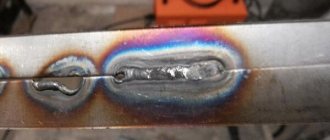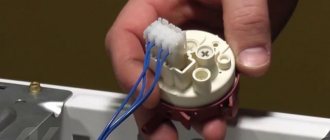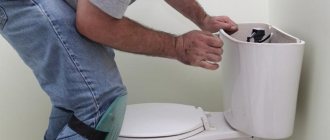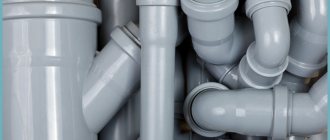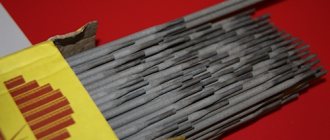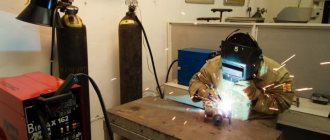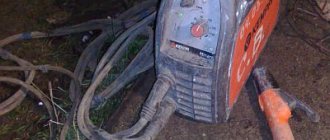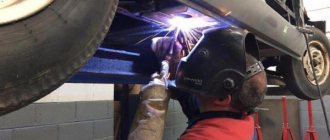What is the root of the problem?
It is necessary to warn that if you are determined to independently study the metalworking process, then you should pay special attention to the purchase of a welding machine.
A qualified specialist can work without any problems with any device, with transformers that do not have a mode setting function, with inexpensive inverter models. A beginner in this business is recommended to purchase a modern model, which is more expensive in cost, but prevents the element from sticking. If you don’t have the financial means to buy or you inherited an old modification, then study the reasons for sticking, which we described below.
Low quality
Before you begin to eliminate electrode sticking, you need to make sure of their quality. Products produced in artisanal conditions can stick even with a perfectly selected electric welding mode.
Counterfeits of well-known manufacturing companies are spreading on the market. Therefore, when purchasing, do not strive for cheapness; be sure to check all the documentation.
But even products from the same manufacturer may differ in different batches. Often the first batches of new brands of electrodes are of higher quality than subsequent ones.
The electrode may stick due to chipped coating. To check the quality of the coating, experienced welders advise, when purchasing, to release the electrode flat from a height of about 2 meters.
The main thing is that the landing surface is level. If the coating breaks off, it means that the electrodes are of poor quality and should not be purchased.
Damp electrodes will also stick. If humidity is high, the arc will be unstable and the welder will have to press the edge of the conductor against the base metal. This will cause sticking due to a short arc.
In this case, the quality of the welded joint is significantly reduced. The seam will become oversaturated with hydrogen, and cracks will form at the joint.
When purchasing, pay attention to the presence of a characteristic white coating on the surface of the coating. If plaque is present, it is necessary to calcine the consumables before work.
The easiest way is to short-circuit the electrode on the metal surface for a while. After inserting it into the holder, press it against the steel surface and hold for about 5 seconds. Then, by moving the holder to the side and up, tear off the electrode and begin welding the joint.
But this method leads to burning of the contacts, so it is better to use it if there is no possibility of calcination under civil conditions. For normal roasting, just place them in the oven at 150°C for 40 minutes.
Damp electrodes
If the arc goes out and a short circuit occurs, inspect the surface of the element. During production, a metal or non-metallic rod is coated throughout the entire post with a special coating in a thick or thin layer. Another option is welding wire, which is also the consumable part. The chemical composition of the mixture is different and each manufacturing company creates its own proportions for the content of carbon, silicon and phosphorus, since there are no strict regulations in this regard. If the composition is not particularly critical for the efficiency of use, then improper storage of the working element can lead to loss of quality characteristics and, as a consequence, sticking. Manufacturers pay special attention to packaging, using paper containers and polyethylene as additional protection against water penetration. The instructions say that if the integrity of the packaging material is damaged, it is necessary to use the consumables as soon as possible. Otherwise, the coating will be subject to accumulation of excess moisture.
The second reason for electrode sticking during electric welding (welding) is poor preparation of the workpiece surface
The plasma barrel immediately goes out after ignition due to the fact that the part has various contaminants: oxide film, rust, scale, bubbles, slag adhesion, chips, dust, etc. Before welding, the part must be cleaned with a rotating wire brush, scraped using a grinder and degreased with a special liquid. An inexperienced master, rushing to complete the work on time, does not pay attention to this and, in fact, loses productivity, since he cannot ignite the arc.
Incorrect device settings for welding parts
For proper melting, it is necessary to select the current mode. If the feed is insufficient, the tip of the rod melts and it partially sticks to the workpiece. If there is excess current, the consumable is simply destroyed.
Another reason why the electrode sticks (sticks) during electric welding is the discrepancy between the thickness of the material and the diameter of the working element.
We provide you with a table with approximate parameters that should be installed on the equipment depending on the intended task.
| Electric Flow Power | Diameter of the consumable in millimeters | Metal alloy thickness(mm) |
| 25-50 | 1-2 | 1,6 |
| 40-80 | 2-3 | 2 |
| 60-100 | 2-3 | 2,5 |
| 80-160 | 3-4 | 3-4 |
| 80-160 | 3-4 | 4-5 |
It is worth noting that a special influence is exerted mainly by excess or insufficient current strength. If you set up your equipment correctly, the welding quality will not change when melting metal workpieces of any parameters.
The reasons why the electrode sticks when welding with an inverter are poor consumables
It is surprising what is wrong if the coating of the rod is dry.
The problem lies in the low quality of the product. This can only happen in one case – if the products were manufactured in violation of the production technology. Factories must have a quality control department, the scope of which includes independent compliance control, which is a guarantor of the quality of products offered to the consumer. The fact of acceptance must be reflected in the relevant documents: certificate, instructions for use, technical data sheet, label, etc. Low-quality consumables are most likely produced by handicraft methods in underground workshops or garages. Non-certified products have a low cost, but do not guarantee business success. Therefore, you should not immediately purchase products; check one copy in this way: lift the rod above your head and throw it with a flourish onto a hard surface (concrete, asphalt). If the coating crumbles, it is better to refuse the purchase.
Incorrect arc ignition
A beginner in this process has no experience, so he does not know that the operation can be performed in two ways:
- The working element is brought vertically closer to the plane of the part and, after touching, it is very quickly moved upward to a certain distance along the length of the column.
- They scratch “casually” from the surface of the material.
The most common mistake can be seen when an inexperienced craftsman taps for a long time and at the same time leaves the tip of the rod on the surface being welded for a long time. Because of this, excessive heating of the workpiece occurs, leading to sticking.
Effect of electric current
We have provided you with a table above from which you can calculate the work. Due to the fear of damage to the workpiece by burning or allowing defects (insufficient or redundant weld layer, interruption of geometry), the young specialist does not adhere to the permissible parameters, but reduces the power of the device. This leads to the fact that the matter ends before it has even begun, since the current strength is absolutely insufficient for stable contact with the surface. If you have little experience, then use the method of gradually increasing power as needed, this way you will select the right mode. Just conduct an experiment on a defective part that you don’t mind throwing away after the trial work.
How does the power supply affect
Old devices are especially sensitive to unstable parameters, since the voltage on the secondary winding of the transformer directly depends on the power of the power station. If there is insufficient heat, the mechanism in the unit jumps, which leads to the impossibility of igniting the arc, since the voltage is not enough to create a discharge. And if it is possible to perform this action, then the newly ignited plasma barrel will most likely go out, and the tip of the rod will stick to the cooling bath. Unfortunately, the stability of the power supply depends on many factors. This is the terrible quality of power lines, and the further you are from big cities and transformer substations, the worse the situation with electricity is. In addition, voltage can change due to weather conditions, time of day and even seasonality. For high-power devices such as welding machines, poor electrical supplies have a particularly negative impact on their efficiency. During surges, instead of a stable arc, the specialist receives only the flickering of weak sparks, and the transformer emits a loud hum in short circuit mode. Even the use of thin electrodes does not save the situation. As a result, when a powerful load is turned on, a sharp decrease in voltage occurs in the local network, which ultimately can negatively affect the operation of household appliances, even to the point of failure. This is fraught not only with failure to complete the assigned task, but also with conflict situations with neighbors.
Raw metal
Many citizens who do not have special knowledge and do not have a professional level of skill mistakenly think that the quality of the weld will not suffer if the material is not cleaned in advance. We refute this opinion.
Cleaning must be done in advance of assembly. At the intended welding site, various contaminants are removed from the element: rust, scale, oil deposits, water, etc., since their presence threatens the formation of micropores and other defects. In addition, you should pay special attention to the gaps between the edges. If a connection has already taken place, then the slightly dirty point should be blown with high-pressure compressed air or the burning method using a gas torch should be used.
Use the cleaning method that is most convenient for you:
- Sandblasting or hydrosandblasting machine.
- Mechanical wire brush.
- Needle cutters.
- Friction with abrasive particles.
- Etching with acid or alkali solutions.
- Washing with different solvents.
Depending on the composition and shape of the welded material, the surfaces should be thoroughly cleaned of molding soil, and the remnants of the casting film should be removed by removing them with an emery stone at the joints.
Lack of experience of the master
During the process, a young specialist often asks “experienced” welders how to light and weld the electrode so that it does not stick.
In addition to the reasons we have listed above, there is a fairly serious reason for taking effective action. The error lies in the incorrectly calculated distance from the device to the soldering zone. An air gap that is too short threatens to extinguish the arc; the “newbie,” trying to save the situation, digs himself deeper and deeper, brings the tip of the rod even closer and thereby provokes it to fall into the bath, where sticking itself occurs.
In this case, do not despair; you will have to spend a little time learning how to operate an inverter device. And the material must be selected, made from simple structural steel. Only after getting your hands on an experimental workpiece can you move on to more serious raw materials, such as stainless steel or alloyed iron.
How to fix
Sticking is not an insurmountable problem. Modern and serviceable equipment, high-quality materials, proper storage, careful preparation of workpieces for work and a set of experience allow the welder to forget about annoying sticking.
Preparation
Electrodes removed from a freshly opened film package do not require additional preparation; they can be immediately cooked. They are not in danger of sticking.
But after just a few hours of being outdoors, they can gain moisture. Then they should be dried before work. For this purpose, special drying electric ovens are used in production, heating up to 400°C.
You can use a muffle furnace in your home workshop. Let's allow the electrodes to warm up on the radiator, but this will take several hours. It is unacceptable to use an open fire for drying - the flame temperature may exceed the permissible one.
Important! You can warm up welding materials three times. Then the coating loses its properties
Hardware settings
Before starting work, you need to accurately determine the type of alloy that is going to be welded and measure the thickness of the workpiece. In accordance with these parameters, using the reference tables given in the welding machine’s passport or on the manufacturer’s portal, the thickness of the electrode and the required welding current are selected.
It should be understood that these are basic parameters; depending on the specific conditions, features of the apparatus, seam configuration and the experience of the welder, some amendments may be made to them.
Particular care must be taken when selecting parameters for thin blank sheets or body parts. The risk of burning through is especially high for them. in this case, start from the lower limit of the table range, gradually increasing the current until optimal penetration is achieved.
Inexperienced welders often ask why the electrode peaks, that is, the coating on one side does not burn completely, forming a peak. This occurs due to an overestimation of the welding current and non-compliance with the angle of inclination of the rod to the workpiece.
In addition to setting up the unit, it is also necessary to thoroughly prepare the surface.
In addition to the seam and heat-affected area, you should also clean and degrease the place where the bulk wire is connected to the workpiece.
Learn how to strike an arc correctly
Proper ignition of the arc avoids sticking. What you need to do in two main ways:
- tapping;
- by striking.
If you don’t have much work experience, then it is better to ignite the arc with a short strike, reminiscent of striking a match on a box. In this case, the electrode must be held perpendicular to the plane of the part. As soon as the arc flares up, you need to tilt it 15 degrees back, and, without stopping in one place, smoothly and evenly move the seam along the intended line. This prevents the tip from sticking.
Two ways to ignite an electric arc. For beginners, it is recommended to ignite the arc by striking.
It is important to maintain a constant gap between the tip of the rod and the workpiece. Exceeding the arc length leads to incomplete penetration and increases the risk of combustion failure
The holder should also not be tilted at too sharp an angle. At the same time, the conditions for heating the workpiece worsen, the weld pool narrows, and the seam will become weak.
To prevent the electrode from sticking, it is necessary to use dry and high-quality welding materials. You should also correctly set the operating parameters of the welding machine.
Finally, it is important to use proper arc starting techniques.
What about the inverter device?
The huge selection of inverter devices on the market complicates the choice to a certain extent: this is where the “eyes run wide” symptom begins to operate. This is especially true for not very experienced craftsmen who have not encountered the problem of electrodes sticking, but have only read about it.
Meanwhile, the requirements for inverter devices are quite specific, so choosing and purchasing the right device is quite possible. So that the acquaintance with sticking remains purely theoretical and the question “why the electrode sticks” never arises on the professional path in the future.
Anti-stick function in the inverter device.
Here are the requirements for the inverter device that will reduce the risk:
- Anti-stick or anti-stick function : when stuck, the current is automatically reset to zero, resulting in the preservation of the electrode and the inverter itself. This also includes a function of pulsed increase in welding current, which prevents the weld from being interrupted if the arc is about to break.
- Hot start function for fast and high-quality ignition of the arc.
- Automatic switch – including overheat protection.
- Supply voltage range from 160 to 250 V for operation during network power surges.
Summary
Which electrodes are best for cooking with an inverter? Of the exact unconditional requirements, there is only one: these must be electrodes for DC welding. All other requirements are actually advice, that is, they have the status of “desirability”.
Don’t skimp on quality consumables, store them in the right places. Before purchasing, check the specifications of the metals and alloys that you are going to weld, and the requirements for suitable electrodes.
Check before work, monitor the packaging, learn to ignite and hold the arc correctly. All of the above fits into the general concept. This is following the rules and technologies, which actually means increasing the professionalism of the welder. That's what we wish for you. Good luck!
